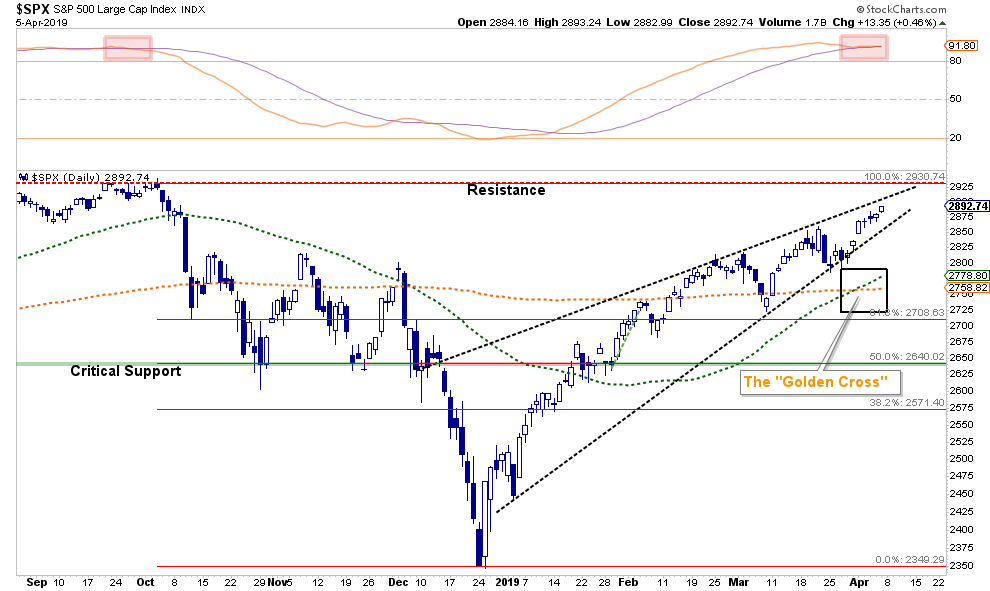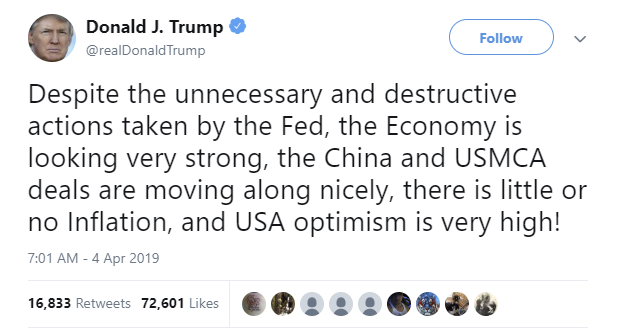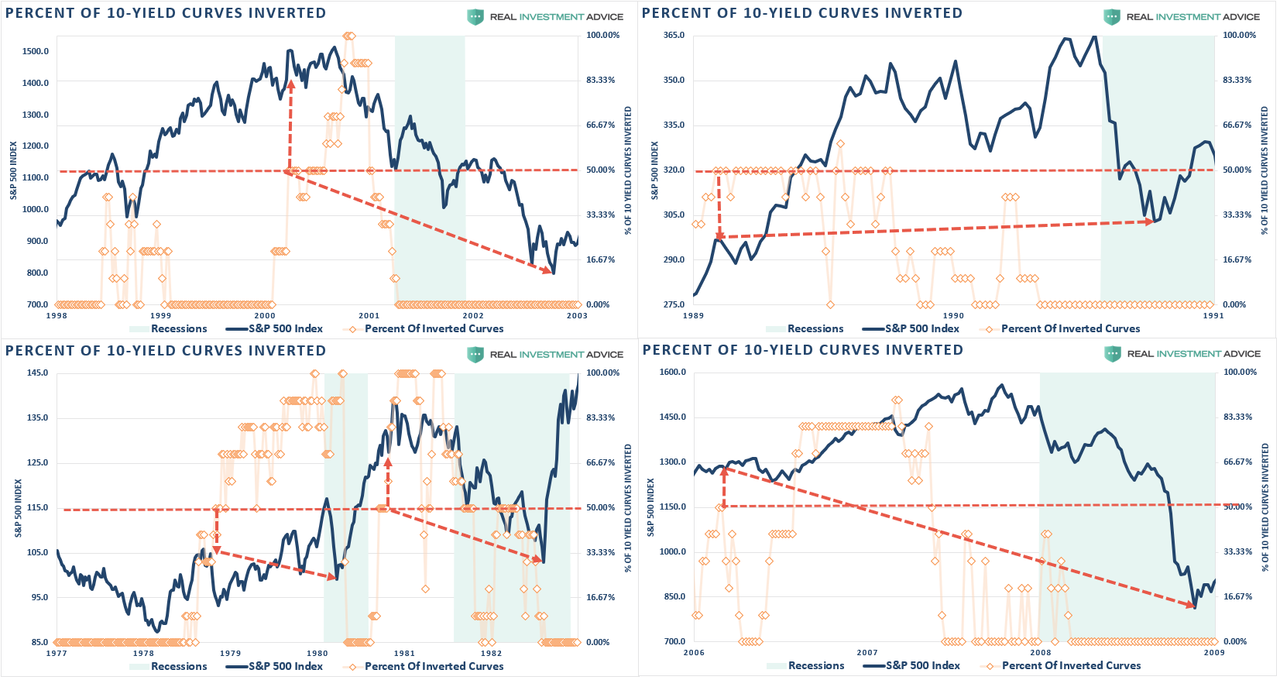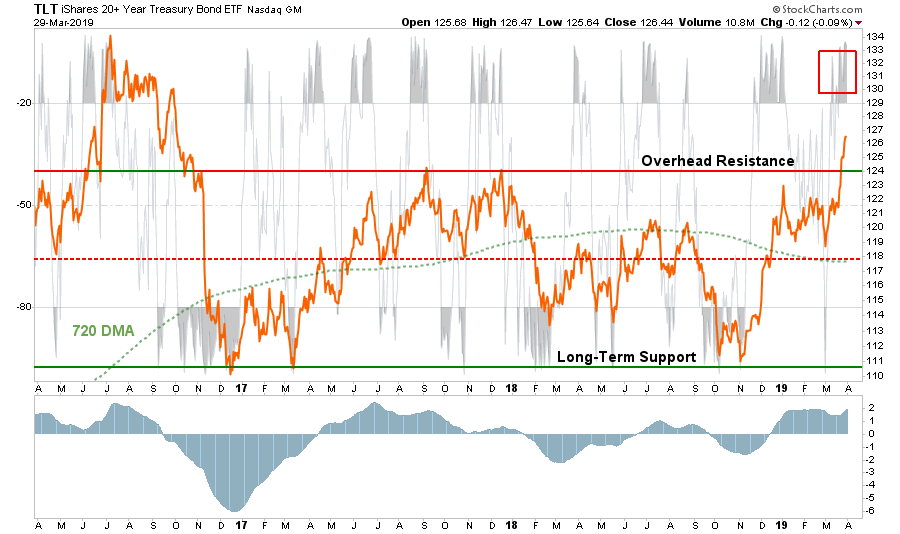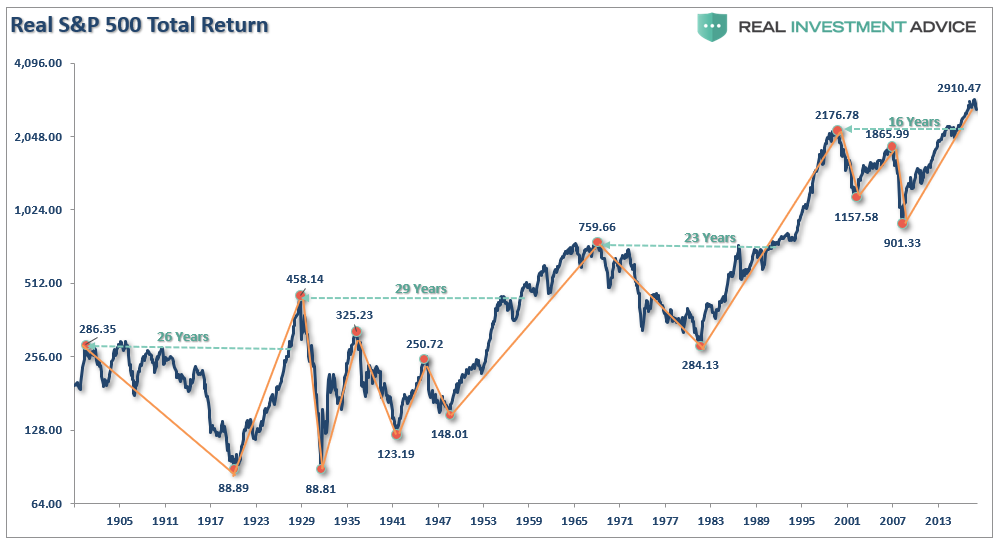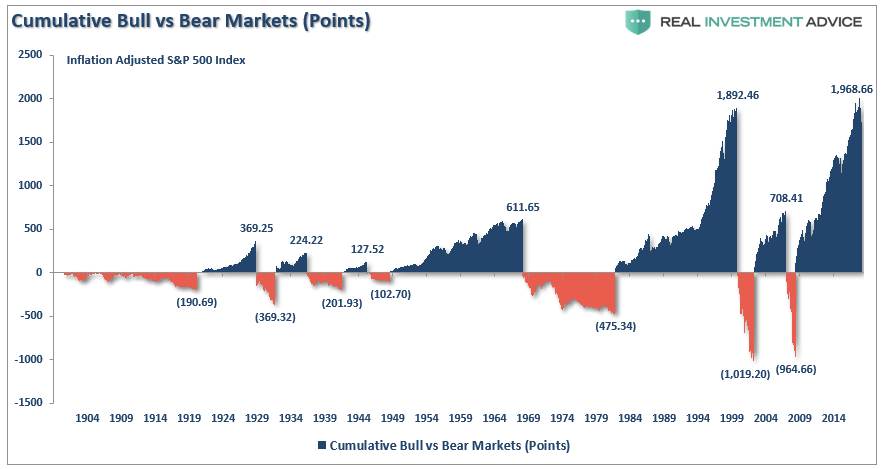Authored by Lance Roberts via RealInvestmentAdvice.com,
A Run For The Highs Continues
“Fueling the markets are statements from past and present Fed Governors that are not only dovish but discuss a resumption of QE and negative interest rates. Former Fed Chairman, Janet Yellen, recently said the Fed needs more tools to battle a financial crisis. This is the same Janet Yellen that, in June of 2017, stated that she did not believe we would have a financial crisis in our lifetimes.
The Fed is sounding the alarms.” – Michael Lebowitz, RIAPRO.net (Try it FREE for 30-days)
Last week, we discussed the market’s advance from the lows and why retesting old highs was quite probable. To wit:
“The markets are close to registering a ‘golden cross.’ This is some of that technical ‘voodoo’ where the 50-day moving average (dma) crosses above the longer-term 200-dma. This ‘cross’ provides substantial support for stocks at that level and limits downside risk to some degree in the short-term.”
Not surprisingly, this headline on Friday:
“S&P Logs Longest Win Streak In 18-Months After Strong Jobs Report.”
Okay, two things are important here:
-
If this is the longest “win streak” in 18-months that should tell you we are likely near the end of the run and not the beginning. That doesn’t mean the markets are going to crash, but a short-term correction is likely to provide a better risk-reward entry point.
-
The employment report wasn’t why the market rallied on Friday. In actuality, it was Trump’s comments about “trade,” the Fed needing lower rates, and the nomination of Herman Cain, another Trump supporter along with Stephen Moore, to the Federal Reserve Board.
So, stocks rallied once again on the same trade deal talk we have had for weeks with both China and the US claiming progress in talks and pushing for a rapid conclusion. While President Trump was talking up prospects for a “monumental” agreement, such will likely be an agreement in “name only” with no actions required until 2025. To wit:
“China would commit by 2025 to buy more U.S. commodities, including soybeans and energy products, and allow 100 percent foreign ownership for U.S. companies operating in China as a binding pledge that can trigger retaliation from the U.S. if left unfulfilled.”
If this turns out to be the case, President Trump may claim a victory for resolving a dispute he started in the first place but the markets will likely quickly see through the fiasco.
The real impetus behind the rally last week was the comments from Trump the Fed should drop interest rates and start more “Q.E.” As my dear Canadian friend, Victor Adair of Polar Futures Group, penned on Friday:
“‘Politics’ is increasingly on a collision course with Central Banks…and that may be become the ‘new’ most important driver of world markets.
On July 7/18 I wrote: Politics has replaced Central Banks as the most important driver of world markets according to Christopher Wood, financial analyst with CLSA, and I agree. It seems that for the last several years it was, ‘All about the Central Banks,’ but since Trump’s election the markets have been buffeted at least as much by political developments as by Central Bank actions. The recent Italian ‘existential crisis’ is a fine example of politics rattling the markets.
Today we have Trump constantly badgering Fed Chairman Powell, now calling for interest rate cuts and the resumption of QE…and proposing to nominate Stephen Moore and Herman Cain to the Fed board. (Not to mention Larry Kudlow calling for the Fed to cut interest rates by 50 bps.)
Is this really a Republican President effectively calling for the Fed to begin monetizing government deficits? We’ve come a long way from Fed Chair William Martin declaring that it was the Fed’s job ‘to take away the punch bowl just as the party gets going.’”
Importantly, and as we will discuss in more detail momentarily, lowering interest rates and introducing QE are tools the Fed will use when real weakness shows up in the economy. While Trump may want further “emergency measures,” he isn’t arguing the “need” for those measures very well.
The infighting though is setting up an serious collision between “Fed Independence” and the White House. Trump wants lower rates and Q.E. to continue to inflate asset prices since he has pegged the “success” of his Presidency on the stock market. (This was a mistake we have argued previously.) However, the Fed is already beginning to leak “hints” about needing to hike rates further due to the same reasons Trump tweets about – a still growing economy.(This is a reversal of the very policy comments which sparked the rebound from the December 24th lows.)
Cleveland Fed President Loretta Mester:
“Could we be done with policy rate increases this cycle? It is possible, but if the economy performs along the lines I think is the most likely case…the fed-funds rate may need to move a bit higher than current levels.”
Philadelphia Fed President Patrick Harker:
“I continue to be in ‘wait-and-see mode‘ with expectations of at most, one hike for 2019 and one for 2020.”
Those comments don’t align with a Fed eager to sit on the sidelines, reduce rates, or begin to inject further stimulus. Furthermore, Fed officials think the economy is in a good place with low unemployment and benign inflation. If they sense a slowdown, Fed officials would first act by trimming their benchmark interest rate.
Then, there is the question of its effectiveness anyway:
“The current belief is that QE4 will be implemented at the first hint of a more protracted downturn in the market. However, as we noted above, QE will likely only be employed when rate reductions aren’t enough. Such was noted in 2016 by David Reifschneider, deputy director of the division of research and statistics for the Federal Reserve Board in Washington, D.C., released a staff working paper entitled ‘Gauging The Ability Of The FOMC To Respond To Future Recessions.‘
The conclusion was simply this:
‘Simulations of the FRB/US model of a severe recession suggest that large-scale asset purchases and forward guidance about the future path of the federal funds rate should be able to provide enough additional accommodation to fully compensate for a more limited [ability] to cut short-term interest rates in most, but probably not all, circumstances.’
In other words, the Federal Reserve is rapidly becoming aware they have become caught in a liquidity trap keeping them unable to raise interest rates sufficiently to reload that particular policy tool. There are certainly growing indications, as discussed recently, the U.S. economy maybe be heading towards the next recession.
Interestingly, David compared three policy approaches to offset the next recession.
Fed funds goes into negative territory but there is no breakdown in the structure of economic relationships.
Fed funds returns to zero and keeps it there long enough for unemployment to return to baseline.
Fed funds returns to zero and the FOMC augments it with additional $2-4 Trillion of QE and forward guidance.
In other words, the Fed is already factoring in a scenario in which a shock to the economy leads to additional QE of either $2 trillion, or in a worst-case scenario, $4 trillion, effectively doubling the current size of the Fed’s balance sheet.”
What investors should realize is that markets will be in a deep bear market, and recession, before QE would be restarted. However, that appears to be a point lost on market participants currently. As Victor concluded:
“The benchmark S+P 500 Index (my bellwether for global risk appetite) had its best Q1 performance in over 20 years and is now only a few percentage points away from All-Time-Highs. Monetary conditions are easy, FOMO and TINA are the key words while DeMark technical indicators and sentiment measures are at extremes. Implied Volatility keeps falling as stocks rally…currently at one month lows.”
He is right, But we are only one-quarter of the way through the year, and while stocks could well reach all-time highs, the potential for a decent correction has been put into place.
“A veteran Chicago trader told me the other day that, ‘stocks are bid because there are no alternatives to lower interest rates.’ He followed that up a few days later with, ‘The only people buying here are people NIT using their own capital.’” – Victor Adair
Risks very much outweighs reward at this juncture and there is no real victory to be had by chasing markets currently.
While we are currently maintaining our long-equity exposure, we did take actions last week to rebalance risk, take profits, and adjust holdings to offset an increase in short-term volatility.
If you don’t know what to do, that is okay.
Cash now has a yield equivalent to inflation with no volatility and no risk of loss. What more could you ask for if you aren’t letting “greed” dictate your investing?
Experience Is The Only Cure
Last week, we discussed the inversion of 50% of the 10-yield curves that we track. To wit:
“This quad-panel chart below shows the 4-previous periods where 50% of 10-different yield curves were inverted. I have drawn a horizontal red dashed line from the first point where 50% of the 10-yield curves we track inverted. I have also denoted the point where you should have sold and the subsequent low.”
“As you can see, in every case, the market did rally a bit after the initial reversion. However, had you reduced your equity-related risk, not only did you bypass a lot of market volatility (which would have led to investor mistakes anyway) but ended up better off than those trying to just ride it out.”
But that was so last week.
The bulls were quick to note that bond yields reversed their inversion this week, so the yield curve was wrong.
Uhm…not so fast, as we noted for our RIA PRO subscribers last week:
“The big move two weeks ago was in Bonds. If you have been following our recommendations of adding bonds to portfolios over the last 13-months, this portion of the portfolio has performed well in offsetting market volatility. As noted previously, intermediate duration bonds remain on a buy signal after increasing exposure last month. However, they are now extremely overbought, so look for a pullback that holds 2.50% on the 10-year Treasury to increase exposure.”
I have UNLOCKED our weekly Major Market Review where I stated;
(If you haven’t tried out RIA PRO you are missing a lot of great stuff – Try it FREE for 30-days.)
-
While resistance remains from $122 to $124, the breakout is bullish for bonds.
-
However, bonds are now EXTREMELY overbought. Look for a pullback to previous resistance which holds to add to exposures.
-
Strong support at the 720-dma (2-years) (green dashed line) which is currently $118.
-
Short-Term Positioning: Bullish
-
Last Week: Hold positions
-
This Week: Trim 1/4 of position just to take profits.
-
Stop-loss adjusted to $121
-
-
Long-Term Positioning: Bullish
As noted, we correctly predicted the pullback in rates this past week because of the extreme overbought condition which existed previously.
However, a TECHNICAL reversion is not the same thing as a statement on the economic recovery. The rotation between bonds and equities this past week does NOT represent a false signal by rates that economic growth is set rebound. As with all things, the trend of the data is far more important than a specific data point and currently the “trend” of yields is lower…not higher.
Furthermore, while the 10-year yield did pick up, 50% of the yields tracked still remain inverted as of Friday.
However, let’s review the important points which HAVE NOT changed:
-
The Fed isn’t hiking rates, but they aren’t reducing them either. (In fact, two Fed officials came out this week stating the Fed is likely to hike rates at least once in 2019 and again in 2020.)
-
The Fed isn’t reducing their balance sheet any more after September, but they aren’t increasing it either.
-
Economic growth outside of China remains weak
-
Employment growth is slowing.
-
There is no massive disaster currently to spur a surge in government spending and reconstruction.
-
There isn’t another stimulus package like tax cuts to fuel a boost in corporate earnings
-
With the deficit already pushing $1 Trillion, there will only be an incremental boost from additional deficit spending this year.
-
Unfortunately, it is also just a function of time until a recession occurs.
As my dad use to tell me growing up:
“The only permanent cure of ignorance, is experience.”
There Is A Decent Probability You Have Never Seen A Bear Market
There is a sizable contingent of investors, and advisors, today who have never been through a real bear market. After a decade long bull-market cycle, which only seems to go up, you can certainly understand why mainstream analysis continues to believe the markets can only go higher.
What is concerning is the rather cavalier attitude the mainstream media takes about bear markets.
“Sure, a correction will eventually come, but that is just part of the deal.”
What gets lost during these bullish cycles, and is found in the most brutal of fashions, is the devastation caused to financial wealth during the inevitable decline.
Let’s look at the S&P 500 inflation-adjusted total return index in a different manner. The first chart shows all of the measurement lines for all the previous bull and bear markets with the number of years required to get back to even.
What you should notice is that in many cases bear markets wiped out essentially a substantial portion, if not all, of the previous bull market advance. This is shown more clearly when we look at a chart of bull and bear markets in terms of points.
Whether or not the current distribution phase is complete, there are many signs suggesting the current Wyckoff cycle may be entering its final stage of completion.
Let me remind you of something Ben Graham said back in 1959:
“‘The more it changes, the more it’s the same thing.’ I have always thought this motto applied to the stock market better than anywhere else. Now the really important part of the proverb is the phrase, ‘the more it changes.’
The economic world has changed radically and will change even more. Most people think now that the essential nature of the stock market has been undergoing a corresponding change. But if my cliché is sound, then the stock market will continue to be essentially what it always was in the past, a place where a big bull market is inevitably followed by a big bear market.
In other words, a place where today’s free lunches are paid for doubly tomorrow. In the light of recent experience, I think the present level of the stock market is an extremely dangerous one.”
He is right, of course, things are little different now than they were then.
For every “bull market” there MUST be a “bear market.”
The sell-off last year, which amazingly enough has already been forgotten, should have been a wake-up call to just how quickly things can change and how damaging they can be.
There is no difference between a 100% gain and a 50% loss.
(For the mathematically challenged: If the market rises from 1000 to 2000 it is a 100% gain. A fall from 2000 to 1000 is a 50% loss. Net return is 0%)
Understanding that investment returns are driven by actual dollar losses, and not percentages, is important in the comprehension of how devastating corrections can be on your financial outcome. So, before sticking your head in the sand and ignoring market risk based on an article touting “long-term investing always wins,” there is a huge difference between just making money and actually reaching your financial goals.
But experience will cure all of that.
via ZeroHedge News http://bit.ly/2UH3Mm8 Tyler Durden
